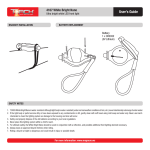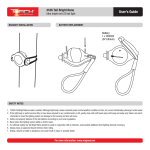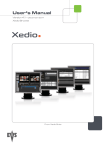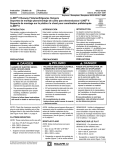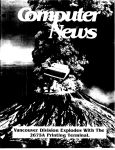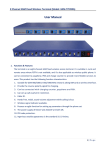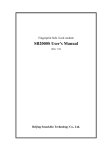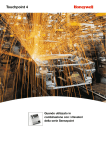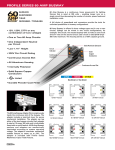Download Normabarre Installation Manual
Transcript
CANALIS KT BUSBAR TRUNKING INSTALLATION GUIDE C L AL UA NU AN MA NM ON TIIO AT LA LL AL TA ST NS T IIN KT SK LIIS AL NA AN CA Canalis® Busway Installation Guide Contents Page January 2001 CONTENTS 1. INTRODUCTION ......................................................................................... 2 2. SAFETY PRECAUTIONS ............................................................................ 3 3. RECEIVING, HANDLING AND STORAGE ................................................. 4 Receiving ................................................................................................. 4 Handling .................................................................................................. 4 Moisture Protection During Storage ........................................................ 5 INSTALLATION ........................................................................................... 6 Pre-Installation Checks ............................................................................ 6 Installation Precautions ........................................................................... 7 Busbar Support Installation ..................................................................... 8 Junction Block Installation ....................................................................... 11 End Cover Installation ............................................................................. 17 Tap-Off Units Installation ......................................................................... 18 5. PRE-ENERGIZATION CHECKS ................................................................. 21 6. ENERGIZING THE EQUIPMENT ................................................................ 22 7. MAINTENANCE .......................................................................................... 23 8. QUESTIONNAIRE ....................................................................................... 25 4. All Rights Reserved © 1 Schneider Electric SAS C L AL UA NU AN MA NM ON TIIO AT LA LL AL TA ST NS T IIN KT SK LIIS AL NA AN CA Canalis® Busway Installation Guide Section 1 – Introduction January 2001 SECTION 1 - INTRODUCTION This manual is a collection of practical information, and proposes general recommendations complementary to the installation regulations, which details the fundamental instructions needed for handling, storage, installation and maintenance of Canalis® busbar trunking equipment manufactured by Schneider Electric SAS. The Purchaser’s engineering, installation and operating personnel should familiarize themselves with the manual and become acquainted with the appearance and characteristics of each piece of Canalis® busway. Proper planning and coordination between trades is important for a efficient installation. Every Canalis® busway device is carefully inspected and packaged at the assembly plant. Construction is checked, both structurally and electrically. After a complete inspection, the busway is prepared for shipment. Each section is packaged for easy handling before installation. The catalogue number is marked on each shipping section. All Rights Reserved © 2 Schneider Electric SAS C L AL UA NU AN MA NM ON TIIO AT LA LL AL TA ST NS T IIN KT SK LIIS AL NA AN CA Canalis® Busway Installation Guide Section 2 – Safety Precautions January 2001 SECTION 2 – SAFETY PRECAUTIONS DANGER HAZARD OF ELECTRIC SHOCK, BURN, OR EXPLOSION l Only qualified electrical maintenance personnel should install, operate, service or maintain this equipment. This document should not be viewed as sufficient for those who are not otherwise qualified to operate, service, or maintain the equipment discussed. l Turn off power to the busway before installing, removing, or working on this equipment. l Always use a properly rated voltage sensing device to confirm power is off. l The successful operation of this equipment depends upon proper handling, installation, operation, and maintenance. Failure to follow these instructions may result in serious injury or death All Rights Reserved © 3 Schneider Electric SAS C L AL UA NU AN MA NM ON TIIO AT LA LL AL TA ST NS T IIN KT SK LIIS AL NA AN CA Canalis® Busway Installation Guide Section 3 – Receiving, Handling and Storage January 2001 SECTION 3 – RECEIVING, HANDLING AND STORAGE WARNING HAZARD OF ELECTRIC SHOCK, BURN, OR EXPLOSION l Protect this equipment from containments such as water, salts, concrete and other corrosive environments before and during installation. l Outdoor equipment is not weather resistant until completely and properly installed. l Do not sit, walk or stand on this equipment. Failure to follow these instructions may result in equipment damage, serious injury or death. RECEIVING Upon receipt, check the packing list against the equipment received to ensure the order and shipment are complete. Claims for shortages or other errors must be in writing to Schneider Electric SAS within 30 days of receipt of shipment. If a claim is not made within 30 days of receipt of shipment, Schneider Electric SAS will not be responsible for repair or replacement. Also upon receipt, immediately inspect the busway sections for any damage that may have occurred during transit. If damage is found or suspected, file a claim with the carrier immediately and notify the nearest Schneider Electric office. HANDLING Handle Canalis® products with care to avoid damage to the internal components, or affecting the external appearance of the casing and the ends of the busbars (connection terminations). At all times, the busway must be supported independently such that its weight does not rest on top of the transformers or switchboards. The distance between such supports should not exceed 3m. Avoid subjecting the busway to twisting, denting, impact, and in general, rough handling. Ensure the handling equipment at the installation site is adequate for handling the busway. Verify the lifting capacity of the crane or other equipment available. All Rights Reserved © 4 Schneider Electric SAS C L AL UA NU AN MA NM ON TIIO AT LA LL AL TA ST NS T IIN KT SK LIIS AL NA AN CA Canalis® Busway Installation Guide Section 3 – Receiving, Handling and Storage January 2001 HANDLING (CONT’D) Exercise care when unpacking. Use nail pullers when unpacking wooden crates. If hoisting the busway with a crane, use nylon straps to distribute the weight of the section. If using cables, insert spreaders to avoid damage to the busway. If using a forklift, position the busway on the fork to distribute the weight properly. Cut the banding that secures the package with band cutters. Use the correct tools to remove the reinforced steel packing at each busway ends. Take care not to damage the steel housing, which could result in a failure of the busway. Avoid using objects with sharp edges to lift the busway. Dispose of all disused packing appropriately. Never drag the busway across the ground. Do not use busbar ends for lifting busway sections or fittings. MOISTURE PROTECTION DURING STORAGE If the busway is not installed and energized immediately, store the busway in its Canalis original packaging and store it in a clean, dry space having a uniform temperature. Busway should not be stored outdoors. However, if outdoor storage is necessary, cover the busway securely to protect it from external weather elements and containments. Temporary electrical heating should be provided beneath the cover to prevent condensation. Heat must be of a suitable temperature and evenly distributed beneath the cover. Outdoor busway is not weather resistant until it is completely and properly installed. During installation, pay special attention to riser busways to protect them from moisture from incomplete roofs, walls and so forth. All Rights Reserved © 5 Schneider Electric SAS C L AL UA NU AN MA NM ON TIIO AT LA LL AL TA ST NS T IIN KT SK LIIS AL NA AN CA Canalis® Busway Installation Guide Section 4 – Installation January 2001 SECTION 4 – INSTALLATION PRE-INSTALLATION CHECKS All Rights Reserved © Proper installation of Canalis® is essential to proper busway operation . · Before installing the busway, conduct an insulation resistance test on each busway device to check for possible damage or contamination during shipment or storage. With an insulation resistance tester rated at 1000 volts, ensure the phase-to-phase, phase-to-neutral, and phase-to-ground isolation. · Ambient temperature limits are –10 C through +40 C. Verify that temperatures of the operating environment are within this range. If not, please apply the derating factors indicated in the product catalogues. · Provide sufficient horizontal and vertical clearance from the walls and ceilings to provide easy access to joints. · Level and align busways (vertically and horizontally) before the final tightening of all joints. · Ensure that all joint surfaces are free of containments. · Align the busbar ends of adjoining sections, verifying proper busbar alignment, before sliding sections together. · Verify that the system phasing matches the busway phasing. o 6 o Schneider Electric SAS C L AL UA NU AN MA NM ON TIIO AT LA LL AL TA ST NS T IIN KT SK LIIS AL NA AN CA Canalis® Busway Installation Guide Section 4 – Installation INSTALLATION PRECAUTIONS January 2001 Depending on the installation orientation of the busways, the following precautions should always be exercised. CAUTION HAZARD OF EQUIPMENT DAMAGE l Always maintain the minimum required clearance distance as shown below. 100 Failure to follow these instructions may result in equipment damage or personal injury. 50 270 100 EDGEWISE INSTALLATION For busways installed edgewise, always maintain : A minimum clearance distance of 100mm from the back of the busways to the edge of the wall. A minimum clearance distance of 270mm from the centre-point of 1 busway run to the next. FLATWISE INSTALLATION For busways installed flatwise, always maintain : A minimum clearance distance of 50mm from the back of the busways to the edge of the wall. A minimum clearance distance of 100mm from the centre-point of 1 busway run to the next. All Rights Reserved © 7 Schneider Electric SAS C L AL UA NU AN MA NM ON TIIO AT LA LL AL TA ST NS T IIN KT SK LIIS AL NA AN CA Canalis® Busway Installation Guide Section 4 – Installation January 2001 STEP 1 : BUSWAY SUPPORT INSTALLATION HORIZONTAL When busways are installed horizontally, the supports should not be more than 3m away. Horizontal fixing brackets (hangers) shall comprise of vertical threaded steel rods. FEEDER / PLUG-IN MOUNTING VERTICAL FEEDER / RISER MOUNTING When busways are installed vertically, the supports should not be more than 4m away. Vertical fixing brackets (spring hangers), will comprise of threaded steel rods with springs, mounting bracket and channel iron. Secure the springs, threaded rods to the channel iron. Adjust the distance of the springs to 125mm from floor level and bolt the channel iron to the floor. Note that the minimum distance between the spring hanger and the wall is 100mm The distance between the 2 channel irons, A , is given in the table below : Aluminium All Rights Reserved © --- 1000A 1200A 1600A 2000A 2500A 3000A 4000A Copper 1000A 1350A 1600A 2000A 2500A 3000A 4000A 5000A A (mm) 134 164 184 224 264 304 384 464 8 Schneider Electric SAS C L AL UA NU AN MA NM ON TIIO AT LA LL AL TA ST NS T IIN KT SK LIIS AL NA AN CA Canalis® Busway Installation Guide Section 4 – Installation January 2001 VERTICAL FEEDER / RISER MOUNTING (CONT’D) & Bolt the mounting bracket to both sides of the casing of the busbar using 8mm diameter bolts. All Rights Reserved © Adjust the mounting bracket to 185mm above the floor level. The springs have a tolerance of ±30 mm to adjust the height of the supports as required. 9 Schneider Electric SAS C L AL UA NU AN MA NM ON TIIO AT LA LL AL TA ST NS T IIN KT SK LIIS AL NA AN CA Canalis® Busway Installation Guide Section 4 – Installation VERTICAL RISER MOUNTING January 2001 500 Note : The minimum distance from the floor level to the centre of the first junction block is 500mm. SAFETY FEATURES All Rights Reserved © Canalis® busways are designed for safety. It’s has been designed such that it is NOT possible to mount the busways if the neutral conductor is not in phase with each other. The neutral conductor of each element MUST be on the same side. 10 Schneider Electric SAS C L AL UA NU AN MA NM ON TIIO AT LA LL AL TA ST NS T IIN KT SK LIIS AL NA AN CA Canalis® Busway Installation Guide Section 4 – Installation STEP 2 : January 2001 JUNCTION BLOCK INSTALLATION Once the busways are mounted on the supports, the junction blocks can be installed. A minimum distance of 40mm between each ends of the busway must be allowed in order to mount the junction block properly. HORIZONTAL MOUNTING. Reminder : When busways are installed horizontally, the supports should not be more than 3m away All Rights Reserved © Cut a piece of wood measuring 40mm in order to ensure that the minimum allowable distance is always met. Place this piece of wood in between the ends of the 2 busway. - Install the lower cover of the joint to set the 40mm dimension and ensure proper alignment of the busway. The piece of wood can then be removed. Insert the junction block, taking note not to tighten it at this stage. 11 Schneider Electric SAS C L AL UA NU AN MA NM ON TIIO AT LA LL AL TA ST NS T IIN KT SK LIIS AL NA AN CA Canalis® Busway Installation Guide Section 4 – Installation January 2001 HORIZONTAL MOUNTING (CONT’D) CAUTION : When installing the junction block, always ensure that the casing is inserted correctly. All Rights Reserved © Close the joint by installing the upper cover of the joint. 12 Schneider Electric SAS C L AL UA NU AN MA NM ON TIIO AT LA LL AL TA ST NS T IIN KT SK LIIS AL NA AN CA Canalis® Busway Installation Guide Section 4 – Installation January 2001 HORIZONTAL MOUNTING (CONT’D) Once the upper cover is installed, the junction block can be tightened. Torque with an 18 inch (457mm) or longer torque wrench until the outer VISITITE® bolt head twists off and the red washer falls off. All Rights Reserved © 13 Schneider Electric SAS C L AL UA NU AN MA NM ON TIIO AT LA LL AL TA ST NS T IIN KT SK LIIS AL NA AN CA Canalis® Busway Installation Guide Section 4 – Installation VERTICAL MOUNTING January 2001 . Reminder : When busways are installed vertically, the supports should not be more than 4m away All Rights Reserved © Cut a piece of wood measuring 40mm in order to ensure that the minimum allowable distance is always met. Place this piece of wood in between the ends of the 2 busway. - Install the lower cover of the joint to set the 40mm dimension and ensure proper alignment of the busway. The piece of wood can then be removed. Insert the junction block, taking note not to tighten it at this stage. 14 Schneider Electric SAS C L AL UA NU AN MA NM ON TIIO AT LA LL AL TA ST NS T IIN KT SK LIIS AL NA AN CA Canalis® Busway Installation Guide Section 4 – Installation January 2001 VERTICAL MOUNTING (CONT’D) CAUTION : When installing the junction block, always ensure that the casing is inserted correctly. All Rights Reserved © Close the joint by installing the upper cover of the joint. 15 Schneider Electric SAS C L AL UA NU AN MA NM ON TIIO AT LA LL AL TA ST NS T IIN KT SK LIIS AL NA AN CA Canalis® Busway Installation Guide Section 4 – Installation January 2001 VERTICAL MOUNTING (CONT’D) Once the upper cover is installed, the junction block can be tightened. Torque with an 18 inch (457mm) or longer torque wrench until the outer VISITITE® bolt head twists off and the red washer falls off. All Rights Reserved © 16 Schneider Electric SAS C L AL UA NU AN MA NM ON TIIO AT LA LL AL TA ST NS T IIN KT SK LIIS AL NA AN CA Canalis® Busway Installation Guide Section 4 – Installation STEP 3 : January 2001 END COVER INSTALLATION Always terminate each busway run with an end cover in order to prevent any contact with live conductors. The method of installation of the end covers are similar for both horizontal and vertical mounting. HORIZONTAL MOUNTING VERTICAL MOUNTING All Rights Reserved © Insert the isolators between the phases bars at the end of the busway runs. Install both side covers first by tightening them together. Install the top cover and bolt them to the casing of the busway as shown. 17 Schneider Electric SAS C L AL UA NU AN MA NM ON TIIO AT LA LL AL TA ST NS T IIN KT SK LIIS AL NA AN CA Canalis® Busway Installation Guide Section 4 – Installation January 2001 STEP 4 : TAP-OFF UNITS INSTALLATION INSTALLATION PRECAUTIONS Depending on the installation orientation of the busways, the following precautions should always be exercised when mounting the tap-off units : CAUTION HAZARD OF EQUIPMENT DAMAGE l Always maintain the minimum required clearance distance as shown below. l Ensure sufficient clearance for the doors of the tap-off units to open or close without obstruction l Ensure sufficient access to the switch or circuit breaker of the tap-off units l When a large number of tap-off units are required to be installed on the same run of trunking, alternate mounting (use the tap-off outlets on both sides of the trunking) of the tap-off units, whenever possible, to allow for additional support brackets. Failure to follow these instructions may result in equipment damage or personal injury. EDGEWISE INSTALLATION FLATWISE INSTALLATION All Rights Reserved © For busways installed flatwise, always maintain : A minimum clearance distance of 500mm from The centre-point of the tap-off units to the edge of the wall. 18 500mm 1000mm For busways installed edgewise, always maintain : A minimum clearance distance (Dmini) of 1000mm from the front of the busways to the edge of the wall, if the tap-off units are mounted facing a wall or column. Schneider Electric SAS C L AL UA NU AN MA NM ON TIIO AT LA LL AL TA ST NS T IIN KT SK LIIS AL NA AN CA Canalis® Busway Installation Guide Section 4 – Installation January 2001 TAP-OFF MOUNTING 25A – 400A CanalisÒ range of Tap-Off Units (25A – 400A), can be plugged-in into the tap-off outlets of the busway trunking. > 400A – 1250A CanalisÒ range of Tap-Off Units (>400A – 1250A), are mounted on the bolt-on-type outlet of the busway trunking and bolted to the busway casing, for additional safety. All Rights Reserved © 19 Schneider Electric SAS C L AL UA NU AN MA NM ON TIIO AT LA LL AL TA ST NS T IIN KT SK LIIS AL NA AN CA Canalis® Busway Installation Guide Section 5 – Pre-Energization Checks January 2001 SECTION 5 – PRE-ENERGIZATION CHECKS Before energizing the busway, some precaution checks are necessary. 1. Carry out a visual check on the conformity of tightening, at the joints and the connections to the transformers and switchboards. All VISI-TITE bolts should have the double-headed bolts broken off. Shutters of the tap-off outlets not used should be closed. 2. Ensure that the protective devices are correctly rated (current, breaking capacity) with respect to the loads supplied, or in accordance with the specification drawings. 3. Check that all the tap-off units are disconnected or isolated (doors open) : offload position. 4. Conduct an Insulation Resistance Test between phase-to-phase, phase-toneutral and phase-to-ground and record the readings. (A sample reading table is shown below) · Open the circuit by disconnecting the trunking from the transformer or by opening the circuit in the switchboard. · Use an Insulation Resistance Tester of 1000V DC to megger between each live conductor, and between the live conductors and the metal casing (PE). · The value of insulation resistance must read at least 1 MW with a rated voltage of 1000V. 5. Check the equi-potential of the protective circuit. 6. Verify the phase rotation of the busway matches the system phasing before reconnecting to the transformers, switchboards etc. Insulation Resistance Reading Table DATE : DATE : DEVICE : DEVICE : Phase SAMPLE All Rights Reserved © Phase MW R–G R–G Y–G Y–G B–G B–G N–G N–G R–Y R–Y R–B R–B Y–B Y–B R–N R–N Y–N Y–N B–N B–N 20 MW Schneider Electric SAS C L AL UA NU AN MA NM ON TIIO AT LA LL AL TA ST NS T IIN KT SK LIIS AL NA AN CA Canalis® Busway Installation Guide Section 6 – Energizing The Equipment January 2001 SECTION 6 – ENERGIZING THE EQUIPMENT DANGER HAZARD OF ELECTRIC SHOCK, BURN, OR EXPLOSION l Only qualified electrical maintenance personnel should install, operate, service or maintain this equipment. This document should not be viewed as sufficient for those who are not otherwise qualified to operate, service, or maintain the equipment discussed. l The successful operation of this equipment depends upon proper handling, installation, operation, and maintenance. Failure to follow these instructions may result in serious injury or death When the equipment is energized for the first time, qualified electrical personnel should be present. If short-circuits and ground faults caused by damage or poor installation practices have not been detected in the pre-energization checks procedure, serious damage can result when the power is turned-on. The busway should have no electrical load on it when it is energized. As busways typically extends through several rooms and floors, ensure that all devices fed from the busway are in the OFF position. Energize the equipment in sequence by starting at the source end and working towards the load end. In other words, energize the main devices, then the feeder devices, and then the branch-circuit devices. Turn the devices to the “ON” position with a firm positive motion. After all overcurrent devices have been turned on, loads such as lighting circuits, contactors, heaters and motors may be turned on. Busways, when operating correctly, will have a moderate hum. Excessive noise may be an indication of hardware that has not been tightened correctly or of metal parts that have been improperly assembled. Occurrence of sparking at any point along the busway is not normal condition. Deenergize the busway immediately. Correct the cause of the sparking condition. Then, conduct an insulation resistance test again according to Section 5 before attempting to energize again. All Rights Reserved © 21 Schneider Electric SAS C L AL UA NU AN MA NM ON TIIO AT LA LL AL TA ST NS T IIN KT SK LIIS AL NA AN CA Canalis® Busway Installation Guide Section 7 – Maintenance January 2001 SECTION 7 – MAINTENANCE DANGER HAZARD OF ELECTRIC SHOCK, BURN, OR EXPLOSION l Only qualified electrical maintenance personnel should install, operate, service or maintain this equipment. This document should not be viewed as sufficient for those who are not otherwise qualified to operate, service, or maintain the equipment discussed. l Turn off power to the busway before installing, removing, or working on this equipment. l Always use a properly rated voltage sensing device to confirm power is off. l The successful operation of this equipment depends upon proper handling, installation, operation, and maintenance. Failure to follow these instructions may result in serious injury or death CAUTION HAZARD OF EQUIPMENT DAMAGE l Hydrocarbon spray propellants and hydrocarbon-based compounds will cause degradation of certain plastics. sprays or Before using products to clean, dry or lubricate components during installation or maintenance, consult your nearest Schneider Electric SAS office. Failure to follow these instructions may result in equipment damage or personal injury. All Rights Reserved © 22 Schneider Electric SAS C L AL UA NU AN MA NM ON TIIO AT LA LL AL TA ST NS T IIN KT SK LIIS AL NA AN CA Canalis® Busway Installation Guide Section 7 – Maintenance January 2001 MAINTENANCE (CONT’D) Canalis® busways are designed to be of minimal maintenance. Inspect the busway once a year or after any severe electrical short circuit or ground fault. Perform the following maintenance procedures : Carefully inspect all visible electrical joints and terminals. Do not remove joint covers. Verify that the bolts and nuts are correctly tightened. Check the torque on joint bolts using a torque wrench. The tightening torque is shown on the connector block and its values are as follows : BOLT TIGHTENING TORQUE HM 16 16 mdaN HM 14 12 mdaN HM 12 7 mdaN HM 10 5 mdaN If any joints or terminations are badly discoloured, corroded or pitted, or if they show evidence of having been subjected to high temperatures, the devices must be replaced with new factory-built devices. Consult your local Schneider Electric SAS office for replacements. Ensure that the mechanisms are in satisfactory operational condition. Lubricate the moving parts of the various mechanisms, if necessary. Similarly, remove any surplus lubrication to prevent the accumulation of any un-wanted foreign bodies. Check the insulation resistance before re-energizing the busway. It is recommended to keep a permanent record of resistance readings. If readings decrease appreciably with time, deterioration is occurring. Conduct the insulation resistance test according to Section 5. Energize the equipment again following the instructions in Section 6. After performing all the above inspections and necessary repairs, it may be desirable to perform an infra-red temperature test on all the electrical connections. Conduct this test after the busway is re-energized and reaches a stabilized operating temperature. Liability Schneider Electric SAS declines all responsibility in the event of maintenance which does not conform to the specifications or not meeting the installation regulations; unsuitable conditions of storage; inappropriate environment to the product (chemical, ambient conditions, atmospheric conditions, etc); incorrect use of the products; non-compliance of installation and/or connection procedures. All Rights Reserved © 23 Schneider Electric SAS C L AL UA NU AN MA NM ON TIIO AT LA LL AL TA ST NS T IIN KT SK LIIS AL NA AN CA Canalis® Busway Installation Guide Section 8 – Questionnaire January 2001 SECTION 7 – QUESTIONNAIRE In order to better meet your expectations, we would ask you to complete this short questionnaire and return it to us. Is the product packaging satisfactory ? Do our products and documents satisfy your requirements ? ### If not, what improvements must be made ? w Documentation : .........……………………………………………….. w Products : .....................……………………………………………… Was your installation easy to commission ? If not, what were the problems ? Are our services satisfactory ? Are you sufficiently well informed on our products and services ? I would like further information on the following products : Other comments or suggestions : Your name and address in order to give a speedy reply : COMMERCIAL REPRESENTATION Schneider Electric SAS 6 rue Lafontaine – BP122 38163 St Marcellin Cedex France Tel : +33 4 76 38 89 25 Fax : +33 4 76 38 89 70 All Rights Reserved © 24 Schneider Electric SAS

























